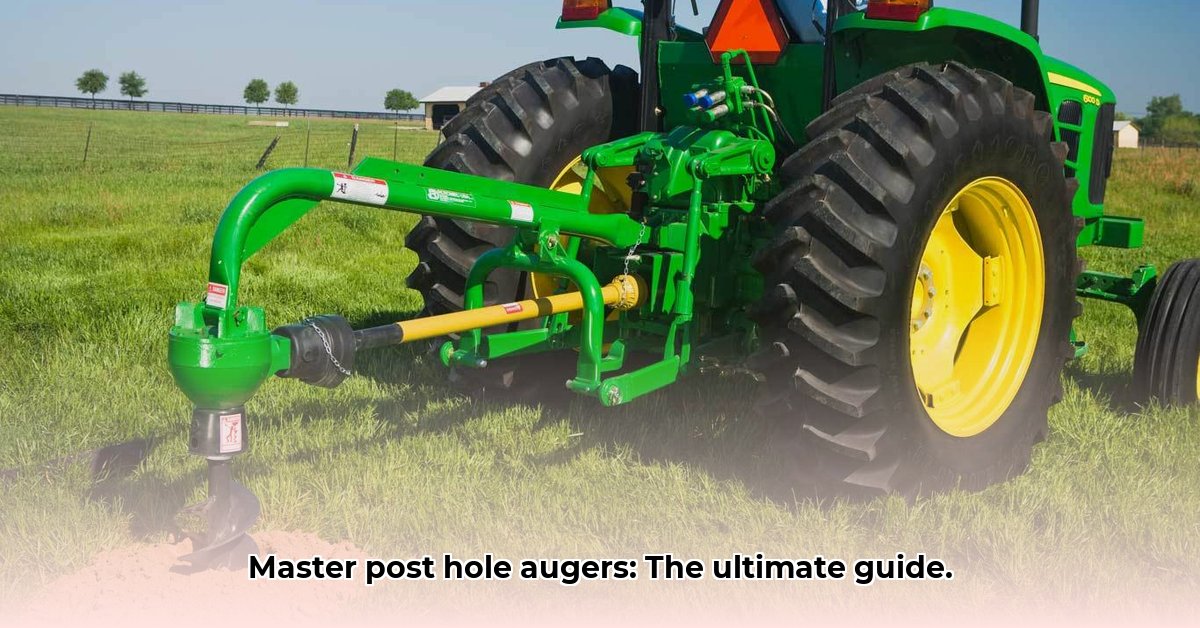
Digging post holes can be strenuous, but a tractor-mounted post hole auger transforms the task. This comprehensive guide covers choosing the right auger, safe operation, maintenance, and troubleshooting, turning you into a post-hole-digging expert. For more compact tractor options, see our guide on compact tractor attachments.
Choosing the Right Post Hole Auger: Soil Type and Project Scope
Selecting the correct auger is crucial for efficiency and safety. Soil type significantly impacts auger selection. Sandy soil is easily managed, while clay or rocky soil demands a more robust auger. Consider the project's scale: a few fence posts need a smaller auger, while larger projects require a larger diameter. Don’t overload your tractor; check its PTO horsepower rating against auger specifications to prevent damage. What's the most common mistake people make when selecting a post hole auger? (Overestimating their tractor's capabilities)
Here's a helpful guide to match augers to soil types:
| Soil Type | Auger Type | Diameter (inches) | Tractor HP Recommendation | Notes |
|---|---|---|---|---|
| Sandy Loam | Standard Earth Auger | 6-12 | 25-50+ | Ideal for most common jobs |
| Clay/Heavy Clay | Heavy-Duty Auger | 6-18 | 40-75+ | Requires more power for dense soil |
| Rocky Soil | Rock Auger | 6-12 | 50-100+ | Built for tough conditions; expect increased wear |
Remember, these are guidelines. Always consult manufacturer specifications for both the auger and your tractor.
Attaching and Using Your Post Hole Auger: A Step-by-Step Guide
Safe and correct attachment is paramount. Always refer to your auger and tractor manuals.
- Secure the Tractor: Park on level ground with the brakes engaged. Safety is non-negotiable.
- Engage the PTO: Carefully engage the tractor's Power Take-Off (PTO) – this powers the auger.
- Lower and Drill: Gently lower the auger, allowing it to dig. Avoid forcing it; let the equipment do the work.
- Depth Control: Adjust the digging depth according to your needs (check your manual for instructions).
- Lifting Safely: Slowly raise the auger once the hole reaches the desired depth. Did you know that 80% of auger-related accidents stem from improper lifting procedures?
Prioritizing Safety: Essential Precautions
Working with heavy machinery demands caution. Always:
- Wear safety glasses, sturdy gloves, and closed-toe shoes.
- Never operate the auger alone. A second person is crucial for assistance in emergencies.
- Keep children and pets at a safe distance.
- Perform a pre-operation visual inspection of the auger and tractor.
Maintaining Your Post Hole Auger: Cleaning, Lubrication, and Troubleshooting
Regular maintenance extends your auger's lifespan. Clean the auger thoroughly after each use, removing soil and debris to prevent corrosion. Regularly lubricate moving parts. Address any damage promptly.
If your auger struggles:
- Check Soil Conditions: Extremely hard soil might require a different auger or a slower pace.
- Auger Condition: A dull bit reduces efficiency; sharpening or replacement may be necessary.
- Depth Settings: Verify the depth setting is correct for the job.
Different Augers for Diverse Applications: Types and Uses
Various augers cater to specific tasks:
- Earth Augers: General-purpose augers suitable for diverse soil types and digging jobs.
- Post Hole Augers: Designed specifically for fence posts and similar applications, offering a wider diameter for stability.
- Rock Augers: Reinforced teeth handle rocky soil, requiring more powerful tractors.
This guide empowers you to master tractor-mounted post hole augers. By choosing the right equipment, prioritizing safety, and performing regular maintenance, you'll efficiently and safely tackle any post hole digging project.